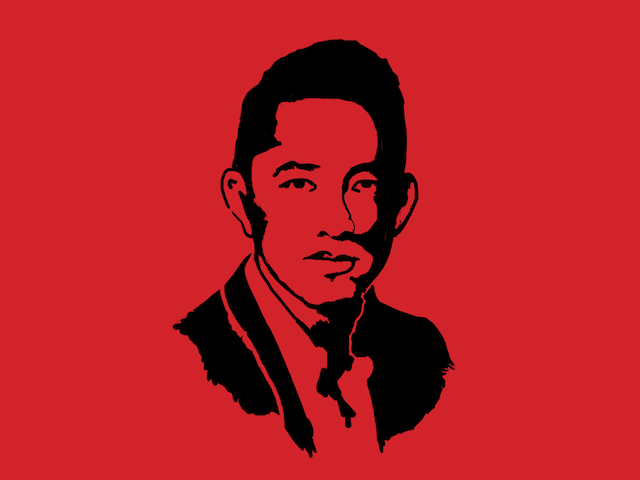Bushra Rehman’s “Two Truths and a Lie” writing workshop was held up at gunpoint last fall. Three writers tell the story of what happened and join a conversation about gentrification and police violence in NYC.

March 23, 2015
On a Thursday evening last November, Bushra Rehman’s “Two Truths and a Lie” autobiographical fiction workshop was held up at gunpoint in Lark Cafe, a coffee shop in Brooklyn. Bushra and her students were forced to give up their laptops, losing years’ worth of writing, and in some cases entire unpublished manuscripts. In the days that followed, the accounts of the robbery that were published in the mainstream media left Bushra and her students deeply frustrated. Not only had their experience been misrepresented, but it was being used as a way to justify increased policing and a ramping up of NYC’s stop-and-frisk policy in the neighborhood. As Bushra writes in the introduction to a series of pieces she and two students from the class, Soniya Munshi and Nina Sharma, published last week in Teachers and Writers Magazine:
My students and I had a choice. We could allow our experience of that night to be misused or we could create and share our own narratives. As teachers in NYC, we have seen young boys of color suspended as early as middle school, a few of many affected by the school-to-prison pipeline. We have witnessed the effects of Stop-and-Frisk on students’ abilities to focus in class. We’ve felt the build-up of rage in the eyes of the public at the list of names as long as generations of young black men killed with no justice served. For many of our students, both high school and undergraduate, Stop-and-Frisk, police brutality, and lack of justice were not issues in the news, they were personal events and obstacles in their lives.
In the weeks that followed, the workshop convened in living rooms across the city and at the Asian American Writers’ Workshop. Bushra and her students began reflecting on the robbery and wrestled with a more difficult question: “Why this young man would need to walk into my classroom with a gun.”
Bushra, Soniya, and Nina are all teachers, and their deeply moving essays are also reflections about what role the classroom has in furthering conversations about race and the criminal justice system. Nina writes of her first year teaching an undergraduate composition class, and the way Bushra’s workshop that fall contrasted with her experience talking to students who, she notes, “took deeply racist positions on social privilege, their guiding arguments being along the lines of: ‘for things to get better, people need to not make such a ‘big deal’ of things.’” Describing the atmosphere of Bushra’s workshop, she writes:
It’s laughter from the edges that I believe we share in common: immigrants, children of immigrants, and marginalized people. It’s our collective inheritance, the laughter that keeps us from punching, the laughter that keeps us from crying. It’s what emerges on the pages.
Soniya, a professor of sociology and Asian American history at CUNY Borough of Manhattan Community College, had been leading class discussions about gentrification in the city with her students, many of whom are working class and of color, when she told them about the robbery. “What I didn’t expect in that first week after the robbery was the role that my students would play in my healing process,” she writes. “I didn’t think of our classroom as a space that could, or should, nourish me in a time of vulnerability.” She continues:
My students expected me to feel angry with the person who robbed us. I didn’t. I hadn’t even spent much time thinking about him, but they were curious to know about this person. What led to his decision to rob us that night? Why did he rob our group and not the customers on the other side of the café? Did he feel bad afterwards? All we could do was speculate. Being able to imagine different possibilities without the need to come up with answers felt remarkably soothing.
Immediately after the robbery, students from Bushra’s class had tracked their stolen laptops to a different neighborhood altogether. But the police officers who arrived on the scene insisted on searching in the immediate vicinity of the cafe, stopping and frisking young black men on the streets. Bushra writes:
[T]he police rushed two students out, saying, “We have someone to ID. Hurry, hurry.” They were yelling, rushing, acting urgent. I wondered how they had someone to ID when the man had worn a mask and we had told them we couldn’t ID anyone.
There were tears in my students’ eyes when they returned. They had sat in the police car as the police pulled over a young black man and his friend while they were walking down the street, stopped them, and frisked them. These students had often been on the other side with boyfriends and friends—they shrank back into the police car, horrified.
One of Soniya’s students asked her if the robbery had changed the way she saw the world. “It was a good question,” she writes. “After some thought, I said that nothing had really changed, but the robbery taught me many things, such as the beautiful ways that people can hold each other in a crisis, as our writers’ group did that night. And, I left the robbery with a deeper responsibility to be active in dialogues about safety and policing in Jackson Heights, Queens, a gentrifying neighborhood where I was born and currently live. It felt good to say that commitment out loud.”
Read all three essays online in the latest issue of Teachers and Writers Magazine:
“The Man Walked In” by Bushra Rehman
“After the Robbery: Week One” by Soniya Munshi
“What I Saw: Notes of a First-Year Teacher” by Nina Sharma



